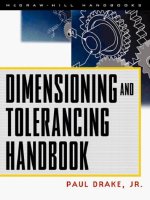Geometric Dimensioning and Tolerancing for Mechanical Design Part 10 pdf
Bạn đang xem bản rút gọn của tài liệu. Xem và tải ngay bản đầy đủ của tài liệu tại đây (212.65 KB, 20 trang )
P1: PBU
MHBD031-10 MHBD031-Cogorno-v5.cls April 11, 2006 23:3
Chapter
10
Concentricity and Symmetry
Both concentricity and symmetry controls are reserved for a few unique tol-
erancing applications. The controls employ the same tolerancing concept but
apply to different geometries. Concentricity controls features constructed about
an axis, and symmetry controls features constructed about a center plane. Con-
centricity and symmetry both locate features by controlling their center points
within a specified tolerance zone. They are typically used when it is important
to accurately balance the mass of a part about its axis or center plane.
Chapter Objectives
After completing this chapter, you will be able to
Define concentricity and symmetry
Specify concentricity and symmetry on drawings
Describe the inspection process of concentricity and symmetry
Explain applications of concentricity and symmetry
Concentricity
Definition
Concentricity is that condition where the median points of all diametrically
opposed points of a surface of revolution are congruent with the axis (or cen-
ter point) of a datum feature. Concentricity applies to correspondingly located
points of two or more radically disposed features, such as the flats on a regular
hexagon, or opposing lobes on features such as an ellipse.
Specifying concentricity
Concentricity is a location control. It has a cylindrical-shaped tolerance zone
that is coaxial with the datum axis. Concentricity tolerance applies only on a
167
Downloaded from Digital Engineering Library @ McGraw-Hill (www.digitalengineeringlibrary.com)
Copyright © 2006 The McGraw-Hill Companies. All rights reserved.
Any use is subject to the Terms of Use as given at the website.
Source: Geometric Dimensioning and Tolerancing for Mechanical Design
P1: PBU
MHBD031-10 MHBD031-Cogorno-v5.cls April 11, 2006 23:3
168 Chapter Ten
Ø 4.000- 4.014
A
Cylindrical
Tolerance
Zone
Ø 2.000 - 2.010
Figure 10-1 Concentricity has a cylindrical tolerance zone and applies at RFS.
regardless of feature size (RFS) basis; it must have at least one datum that also
applies only at RFS. The feature control frame is usually placed beneath the size
dimension or attached to an extension of the dimension line. The concentricity
tolerance has no relationship to the size of the feature being controlled and may
be either larger or smaller than the size tolerance. If the concentricity tolerance
is specified to control the location of a sphere, the tolerance zone is spherical
and its center point is basically located from the datum feature(s).
Interpretation
Concentricity controls all median points of all diametrically opposed points on
the surface of the toleranced feature. The aggregate of all median points, some-
times described as a “cloud of median points,” must lie within a cylindrical
tolerance zone whose axis is coincident with the axis of the datum feature. The
concentricity tolerance is independent of both size and form. Differential mea-
surement excludes size, shape, and form while controlling the median points
of the feature. The feature control frame in Fig. 10-2 specifies a cylindrical
Ø 4.000- 4.014
A
Ø 2.000 - 2.010
Ø.005
Figure 10-2 A concentricity tolerance locating a coaxial feature.
Downloaded from Digital Engineering Library @ McGraw-Hill (www.digitalengineeringlibrary.com)
Copyright © 2006 The McGraw-Hill Companies. All rights reserved.
Any use is subject to the Terms of Use as given at the website.
Concentricity and Symmetry
P1: PBU
MHBD031-10 MHBD031-Cogorno-v5.cls April 11, 2006 23:3
Concentricity and Symmetry 169
tolerance zone .005 in diameter and coaxial with the datum axis. Differential
measurements are taken along and around the toleranced feature to determine
the location of its median points. If all median points fall inside the tolerance
zone, the feature is in tolerance.
Inspection
Concentricity can be inspected, for acceptance only, by placing a dial indica-
tor on the toleranced surface of revolution and rotating the part about the
datum axis. If the full indicator movement (FIM) on the dial indicator does
not exceed the specified tolerance, the feature is acceptable. This technique
is a simple first check that will accept parts but will not reject them, and
it can be used only on surfaces of revolution. Features such as regular poly-
gons and ellipses must be inspected using the traditional method of differen-
tial measurements. If the measurement does exceed the FIM, the part is not
necessarily out of tolerance. To reject a part with a concentricity tolerance, the
datum is placed in a chucking device that will rotate the part about its da-
tum axis. A point on the surface of the toleranced feature is measured with
a dial indicator. The part is then rotated 180
◦
so the diametrically opposed
point can be measured. The difference between the measurements of the two
points determines the location of the median point. This process is repeated a
predetermined number of times. If all median points fall within the tolerance
zone, the feature is in tolerance. The size and form, Rule # 1, are measured
separately.
A
Ø 2.000 - 2.010
Ø 4.000- 4.014
Chucking device
about datum A
Figure 10-3 Inspecting a part with a concentricity tolerance.
Applications of concentricity
The concentricity tolerance is often used to accurately control balance for
high-speed rotating parts. Runout also controls balance, but it controls form
and surface imperfections at the same time. Runout is relatively easy and
Downloaded from Digital Engineering Library @ McGraw-Hill (www.digitalengineeringlibrary.com)
Copyright © 2006 The McGraw-Hill Companies. All rights reserved.
Any use is subject to the Terms of Use as given at the website.
Concentricity and Symmetry
P1: PBU
MHBD031-10 MHBD031-Cogorno-v5.cls April 11, 2006 23:3
170 Chapter Ten
inexpensive to inspect, but manufacturing is more difficult and costly. Con-
centricity is time-consuming and expensive to inspect but less expensive to
manufacture since it is not as rigorous a requirement as runout. Concentricity
is appropriately used for large, expensive parts that must have a small coax-
ial tolerance for balance but need not have the same small tolerance for form
and surface imperfections. Concentricity is also used to control the coaxiality
of noncircular features such as regular polygons and ellipses.
Symmetry
Definition
Symmetry is that condition where the median points of all opposed or corre-
spondingly located points of two or more feature surfaces are congruent with
the axis or center plane of a datum feature.
Specifying symmetry
Symmetry is a location control. It has a tolerance zone that consists of two
parallel planes evenly disposed about the center plane or axis of the da-
tum feature. Symmetry tolerance applies only at RFS; it must have at least
one datum that also applies only at RFS. A feature control frame is usu-
ally placed beneath the size dimension or attached to an extension of the di-
mension line. The symmetry tolerance has no relationship to the size of the
feature being controlled and may be either larger or smaller than the size
tolerance.
Tolerance Zone
A
Unless Otherwise Specified:
.XXX = ± .005
ANGLES = ± 1°
4.000-4.002
2.000-2.002
Datum Feature Center Plane
B
Figure 10-4 The symmetry tolerance zone consists of two parallel planes.
Downloaded from Digital Engineering Library @ McGraw-Hill (www.digitalengineeringlibrary.com)
Copyright © 2006 The McGraw-Hill Companies. All rights reserved.
Any use is subject to the Terms of Use as given at the website.
Concentricity and Symmetry
P1: PBU
MHBD031-10 MHBD031-Cogorno-v5.cls April 11, 2006 23:3
Concentricity and Symmetry 171
B
A
Unless Otherwise Specified:
.XXX = ± .005
ANGLES = ± 1°
4.000-4.002
.010
2.000-2.002
Figure 10-5 A symmetry tolerance locating a symmetrical feature.
Interpretation
Symmetry controls the median points of all opposed or correspondingly located
points of two or more surfaces. The aggregate of all median points, sometimes
described as a “cloud of median points,” must lie within a tolerance zone defined
by two parallel planes equally disposed about the center plane of the datum
feature, i.e., half of the tolerance is on one side of the center plane, and half is
on the other side. The symmetry tolerance is independent of both size and form.
Differential measurement excludes size, shape, and form while controlling the
median points of the feature. The feature control frame in Fig. 10-5 specifies
a tolerance zone consisting of two parallel planes .010 apart, perpendicular to
datum plane A, and equally disposed about datum plane B. Differential mea-
surements are taken between the two surfaces to determine the location of the
median points. If all median points fall inside the tolerance zone, the feature is
in tolerance.
Inspection
A simple method of measuring symmetry is shown in Fig. 10-6. This method
can be used only if the datum surfaces are parallel compared to the symmetry
tolerance. In this example, one of the datum surfaces is placed on the surface
plate. A dial indicator is used to measure a number of points on the surface of
the slot. These measurements are recorded. The part is turned over, and the
process is repeated. The measurements are compared to determine the location
of the median points and whether or not the feature is in tolerance. The size
and form, Rule # 1, are measured separately.
Downloaded from Digital Engineering Library @ McGraw-Hill (www.digitalengineeringlibrary.com)
Copyright © 2006 The McGraw-Hill Companies. All rights reserved.
Any use is subject to the Terms of Use as given at the website.
Concentricity and Symmetry
P1: PBU
MHBD031-10 MHBD031-Cogorno-v5.cls April 11, 2006 23:3
172 Chapter Ten
2.000-2.002
4.000-4.002
A
Figure 10-6
Inspecting a part with a symmetry tolerance.
Applications of symmetry
The symmetry tolerance is often used to accurately control balance for rotating
parts or to insure equal wall thickness. Specify symmetry only when it is neces-
sary because it is time-consuming and expensive to manufacture and inspect.
The symmetry control is appropriately used for large, expensive parts that re-
quire a small symmetry tolerance to balance mass. If the restrictive symmetry
control is not required, a more versatile position tolerance may be used to con-
trol a symmetrical relationship. See chapter 8 for a discussion of the application
of the position control to tolerance symmetrical features.
Summary
Concentricity is that condition where the median points of all diametrically
opposed points of a surface of revolution are congruent with the axis of a
datum feature.
Concentricity is a location control that has a cylindrical tolerance zone coaxial
with the datum axis.
The concentricity tolerance and datum reference apply only on an RFS basis.
The aggregate of all median points must lie within a cylindrical tolerance
zone whose axis is coincident with the axis of the datum feature.
Downloaded from Digital Engineering Library @ McGraw-Hill (www.digitalengineeringlibrary.com)
Copyright © 2006 The McGraw-Hill Companies. All rights reserved.
Any use is subject to the Terms of Use as given at the website.
Concentricity and Symmetry
P1: PBU
MHBD031-10 MHBD031-Cogorno-v5.cls April 11, 2006 23:3
Concentricity and Symmetry 173
The concentricity tolerance is independent of both size and form.
Differential measurement excludes size, shape, and form while controlling
the median points of the feature.
The concentricity tolerance is often used to accurately control balance for
high-speed rotating parts.
Symmetry is that condition where the median points of all opposed or corre-
spondingly located points of two or more feature surfaces are congruent with
the axis or center plane of a datum feature.
Symmetry is a location control that has a tolerance zone that consists of two
parallel planes evenly disposed about the center plane or axis of the datum
feature.
The symmetry tolerance and datum reference apply only at RFS.
The aggregate of all median points must lie within a tolerance zone defined
by two parallel planes equally disposed about the center plane of the datum
feature.
The symmetry tolerance is independent of both size and form.
The symmetry tolerance is often used to accurately control balance for rotat-
ing parts or to insure equal wall thickness.
Specify symmetry only when it is necessary because it is time-consuming and
expensive to manufacture and inspect.
Chapter Review
1. Both concentricity and symmetry controls are reserved for a few
.
2. Concentricity and symmetry both employ the same tolerancing
;
they just apply to different
.
3. Concentricity is that condition where the median points of all diamet-
rically opposed points of a surface of revolution are congruent with
.
4. Concentricity is a
control. It has a
tolerance zone that is coaxial with .
5. Concentricity tolerance applies only on a
basis.
It must have at least
that also applies only
.
6. For concentricity, the aggregate of all
must lie within a tolerance zone
whose axis is coincident with the axis of
.
7. Concentricity can be inspected, for acceptance only, by placing a
on the toleranced surface of revolution and rotating
the part about the
.
Downloaded from Digital Engineering Library @ McGraw-Hill (www.digitalengineeringlibrary.com)
Copyright © 2006 The McGraw-Hill Companies. All rights reserved.
Any use is subject to the Terms of Use as given at the website.
Concentricity and Symmetry
P1: PBU
MHBD031-10 MHBD031-Cogorno-v5.cls April 11, 2006 23:3
174 Chapter Ten
8. To reject parts and to inspect features, such as regular polygons and ellipses,
the traditional method of
is employed.
9. The concentricity tolerance is often used to accurately control
for high-speed rotating parts.
10. Concentricity is time-consuming and expensive to
but less expensive to than the runout tolerance.
11. Symmetry is that condition where the
of all opposed
or correspondingly located points of two or more feature surfaces are
with the of a datum feature.
12. Symmetry is a
control.
13. Symmetry has a tolerance zone that consists of
evenly disposed about the of the datum feature.
14. Symmetry tolerance applies only at
.
15. Symmetry must have at least one
that also applies only at
.
16. The aggregate of all
must lie within a tolerance zone defined by
equally disposed about the center plane of the .
17. The symmetry tolerance is independent of both
.
18. Differential measurement excludes
while controlling the median points of the feature.
19. The symmetry tolerance is often used to accurately control
for rotating parts or to insure equal .
20. Specify symmetry only when it is necessary because it is
to manufacture and inspect.
Downloaded from Digital Engineering Library @ McGraw-Hill (www.digitalengineeringlibrary.com)
Copyright © 2006 The McGraw-Hill Companies. All rights reserved.
Any use is subject to the Terms of Use as given at the website.
Concentricity and Symmetry
P1: PBU
MHBD031-10 MHBD031-Cogorno-v5.cls April 11, 2006 23:3
Concentricity and Symmetry 175
Problems
Ø 7.990-8.000
Ø 3.995-4.000
A
Figure 10-7 Coaxiality of a cylinder: Problem 1.
1. The mass of the high-speed rotating part in Fig. 10-7 must be accurately bal-
anced. The form of the surface is sufficiently controlled by the size tolerance.
Specify a coaxiality control for the axis of the 4.000-inch diameter within a
tolerance of .001 at RFS to datum A at RFS.
Figure 10-8 Coaxiality of an ellipse: Problem 2.
2. The mass of the ellipse shown in Fig. 10-8 must be accurately balanced.
Specify a coaxiality control that will locate the median points of the ellipse
within a tolerance of .004 at RFS to datum A at RFS.
Downloaded from Digital Engineering Library @ McGraw-Hill (www.digitalengineeringlibrary.com)
Copyright © 2006 The McGraw-Hill Companies. All rights reserved.
Any use is subject to the Terms of Use as given at the website.
Concentricity and Symmetry
P1: PBU
MHBD031-10 MHBD031-Cogorno-v5.cls April 11, 2006 23:3
176 Chapter Ten
3 X 24.990-25.000
Figure 10-9 Coaxiality of the hexagon: Problem 3.
3. The mass of the hexagon shown in Fig. 10-9 must be accurately balanced.
Specify a coaxiality control for the median points of the hexagon within a
tolerance of .005 at RFS to datum A at RFS.
2.000-2.0044.000
A
Figure 10-10 Symmetry of the slot: Problem 4.
4. The part in Fig. 10-10 rotates at a high speed, and the mass must be accu-
rately balanced. Specify a geometric tolerance that will centrally locate the
slot in this part within a tolerance of .005 at RFS to datum A at RFS.
Downloaded from Digital Engineering Library @ McGraw-Hill (www.digitalengineeringlibrary.com)
Copyright © 2006 The McGraw-Hill Companies. All rights reserved.
Any use is subject to the Terms of Use as given at the website.
Concentricity and Symmetry
P1: PBU
MHBD031-11 MHBD031-Cogorno-v6.cls April 10, 2006 20:56
Chapter
11
Runout
Runout is a surface control. It controls surfaces constructed around a datum
axis and surfaces constructed perpendicular to a datum axis. Runout controls
several characteristics of surfaces of revolution, such as coaxiality and circu-
larity, as that surface is rotated about its datum axis.
Chapter Objectives
After completing this chapter, you will be able to
Explain the difference between circular and total runout
Specify runout and partial runout
Explain the application of multiple datum features
Explain the meaning of face and diameter datums
Specify geometric controls to refine datum features
Explain the surface relationship between features controlled with runout
Inspect runout
Definition
Runout is a composite tolerance used to control the functional relationship of
one or more features of a part to a datum axis.
Circular Runout
Circular runout applies to every circular element on the surface of a part
constructed either around its datum axis or perpendicular to its datum axis,
while the part is rotated 360
◦
about that datum axis. Circular runout tolerance
177
Downloaded from Digital Engineering Library @ McGraw-Hill (www.digitalengineeringlibrary.com)
Copyright © 2006 The McGraw-Hill Companies. All rights reserved.
Any use is subject to the Terms of Use as given at the website.
Source: Geometric Dimensioning and Tolerancing for Mechanical Design
P1: PBU
MHBD031-11 MHBD031-Cogorno-v6.cls April 10, 2006 20:56
178 Chapter Eleven
A
A
Figure 11-1 Circular runout applied around a datum axis and perpendicular to a datum axis.
applies independently to each circular line element at each measurement posi-
tion and may easily be applied to cones and curved profiles constructed around
a datum axis. Where applied to surfaces constructed around a datum axis, cir-
cular runout controls a combination of variations in circularity and coaxiality.
Where applied to surfaces at a 90
◦
angle to a datum axis, circular runout con-
trols variations in perpendicularity of circular elements to its datum axis, that
is, total runout controls wobble.
Total Runout
Total runout is a compound control that applies to all elements on the sur-
face of a part either around its datum axis or perpendicular to its datum axis,
as the part is rotated 360
◦
about that datum axis. Total runout tolerance ap-
plies simultaneously to all circular and profile measurement positions. Where
applied to surfaces constructed around a datum axis, total runout controls a
combination of coaxiality, circularity, straightness, angularity, taper, and pro-
file variations of the surface. Where applied to surfaces at a 90
◦
angle to a datum
axis, total runout controls the combination of variations of perpendicularity to
the datum axis and flatness, i.e., total runout controls wobble and concavity or
convexity.
A
A
Figure 11-2 Total runout applied around a datum axis and perpendicular to a datum axis.
Downloaded from Digital Engineering Library @ McGraw-Hill (www.digitalengineeringlibrary.com)
Copyright © 2006 The McGraw-Hill Companies. All rights reserved.
Any use is subject to the Terms of Use as given at the website.
Runout
P1: PBU
MHBD031-11 MHBD031-Cogorno-v6.cls April 10, 2006 20:56
Runout 179
Specifying Runout and Partial Runout
When specifying runout, the feature control frame is connected to the controlled
surface with a leader. In some infrequent instances, the feature control frame
may be attached to the extension of a dimension line if the surface to be con-
trolled is small or inaccessible. The feature control frame consists of a runout
symbol, the numerical tolerance, and at least one datum. No other symbols are
appropriate in the feature control frame. Since runout is a surface control, no
material condition applies; consequently, in effect, runout applies at regard-
less of feature size. Where runout is required for only a portion of a surface, a
thick chain line is drawn on one side adjacent to the profile of the surface and
dimensioned with a basic dimension as shown in Fig. 11-3.
Ø 1.000
A
1.000
Figure 11-3 Specifying runout and partial runout.
Multiple Datum Features
At least one datum must be specified for a runout control. In many cases, two
functional datum diameters are used to support a rotating part such as the
one shown in Fig. 11-4. Datum A is no more important than datum B and vice
versa. Fig. 11-4 shows datums A and B at a slight angle to the true axis, but
taken together, the two datums tend to equalize their axes, producing a single
datum axis truer than the axis either one of the datums would have produced
independently.
Face and Diameter Datums
The face and diameter datum reference frame specified in Fig. 11-5 is quite
a different requirement than the multiple datum feature reference shown in
Downloaded from Digital Engineering Library @ McGraw-Hill (www.digitalengineeringlibrary.com)
Copyright © 2006 The McGraw-Hill Companies. All rights reserved.
Any use is subject to the Terms of Use as given at the website.
Runout
P1: PBU
MHBD031-11 MHBD031-Cogorno-v6.cls April 10, 2006 20:56
180 Chapter Eleven
Figure 11-4 Two datum diameters creating a single datum axis.
Fig. 11-4. Datums A and B are specified in two separate compartments in the
feature control frame. Therefore, datum A is more important than datum B.
That means that the surfaces being controlled must first be perpendicular to
datum plane A and then be rotated about datum axis B, even if datum B is not
exactly perpendicular to datum A.
[.005\A\B
Figure 11-5 Face and diameter datums specified in order of precedence.
Downloaded from Digital Engineering Library @ McGraw-Hill (www.digitalengineeringlibrary.com)
Copyright © 2006 The McGraw-Hill Companies. All rights reserved.
Any use is subject to the Terms of Use as given at the website.
Runout
P1: PBU
MHBD031-11 MHBD031-Cogorno-v6.cls April 10, 2006 20:56
Runout 181
Geometric Controls to Refine Datum Features
It may be particularly important for datum features to have a form control
refinement. Datums A and B in Fig. 11-6 have a cylindricity refinement of
.0005. Design requirements may make it necessary to restrict datum surface
variations with respect to straightness, flatness, circularity, cylindricity, and
parallelism. It may also be necessary to include a runout control for individual
datum features on a multiple datum feature reference, as shown in Fig. 11-6.
Datums A and B are independently controlled with a circular runout tolerance
to datum A–B. This tolerance is not the same as controlling a feature to itself.
In fact, it is expected that datum axis A and datum axis B are coaxial with
datum axis A–B, but in the event that datum A or datum B is out of tolerance
with respect to datum A–B, the part does not meet design requirements.
Figure 11-6 Multiple datum features refined with geometric controls.
Surface Relationships Between Features
If two or more surfaces are controlled with a runout tolerance to a common
datum reference, the worst-case runout between two surfaces is the sum of
the two individual runout tolerances. For example, in Fig. 11-6, the worst-case
runout between the largest diameter and datum D diameter is the sum of .015
plus .005 or a total of .020. The two axes may, in fact, be coaxial; however, at
Downloaded from Digital Engineering Library @ McGraw-Hill (www.digitalengineeringlibrary.com)
Copyright © 2006 The McGraw-Hill Companies. All rights reserved.
Any use is subject to the Terms of Use as given at the website.
Runout
P1: PBU
MHBD031-11 MHBD031-Cogorno-v6.cls April 10, 2006 20:56
182 Chapter Eleven
Ø 4.000-4.020
Ø 2.000
4.000
4.020
.010
Datum Feature A
Chuck or Collet
Simulated Datum A
Datum Axis A
A
Possible Shape of Feature
Figure 11-7
Inspecting circular runout relative to a datum axis.
worst case, the surface of the larger diameter could be translated .015 in one
direction, and the surface of datum D could also be translated .005 in the other
direction producing a difference of .020 between the two surfaces.
If two features have a specific relationship between them, one should be toler-
anced directly to the other and not through a common datum axis. Figure 11-6
shows a .500 internal diameter controlled directly with a runout tolerance of
.001 to datum D rather than controlling each feature to datum A–B. If the Ø
.500 hole had been toleranced to datums A–B, the runout tolerance between
the hole and datum D would be a total of .006.
In Fig. 11-6, the multiple leaders directed from the .015 circular runout fea-
ture control frame to the five surfaces of the part may be specified without
affecting the runout tolerance. It makes no difference whether one or several
leaders are used with a feature control frame as long as the runout tolerance
and datum feature(s) are the same.
Inspecting Runout
When inspecting circular runout, the feature, first, must fall within the speci-
fied size limits. It must also satisfy Rule 1, i.e., it may not exceed the boundary
Downloaded from Digital Engineering Library @ McGraw-Hill (www.digitalengineeringlibrary.com)
Copyright © 2006 The McGraw-Hill Companies. All rights reserved.
Any use is subject to the Terms of Use as given at the website.
Runout
P1: PBU
MHBD031-11 MHBD031-Cogorno-v6.cls April 10, 2006 20:56
Runout 183
of perfect form at maximum material condition. The datum feature is then
mounted in a chuck or a collet. With a dial indicator contacting the surface to
be inspected, the part is rotated 360
◦
about its simulated datum axis. Several
measuring positions are inspected. If the full indicator movement (FIM) does
not exceed the specified runout tolerance, the feature is acceptable. Runout tol-
erance may be larger than the size tolerance. If the runout tolerance is larger
than the size tolerance and no other geometric tolerance is applied, the size
tolerance controls the form. If the size tolerance is larger than the runout tol-
erance, circular runout refines circularity as well as controls coaxiality.
The same preliminary checks required for circular runout are also required
for total runout. Just as when inspecting circular runout, a dial indicator con-
tacts the surface to be inspected, but the dial indicator is moved along the full
length of the feature’s profile as the part is rotated 360
◦
about its simulated da-
tum axis. If the FIM does not exceed the specified runout tolerance, the feature
is acceptable.
Summary
Runout is a composite tolerance used to control the functional relationship of
one or more features of a part to a datum axis.
Circular runout applies to every circular element on the surface of a part
constructed either around a datum axis or perpendicular to a datum axis, as
the part is rotated 360
◦
about its datum axis.
Total runout is a compound control that applies to all elements on the surface
of a part either around a datum axis or perpendicular to a datum axis, as the
part is rotated 360
◦
about its datum axis.
When specifying runout, the feature control frame consists of a runout sym-
bol, the numerical tolerance, and at least one datum. No other symbols are
appropriate in the feature control frame.
Two datum diameters may be used to control a rotating part.
Face and diameter datums are specified in order of precedence.
Datum features may have a form control refinement.
If two or more surfaces are controlled with a runout tolerance to a common
datum reference, the worst-case runout between two surfaces is the sum of
the two individual runout tolerances.
If two features have a specific relationship between them, one should be tol-
eranced to the other.
Several leaders may be used with a single feature control frame as long as
the runout tolerance and datum feature(s) are the same.
Downloaded from Digital Engineering Library @ McGraw-Hill (www.digitalengineeringlibrary.com)
Copyright © 2006 The McGraw-Hill Companies. All rights reserved.
Any use is subject to the Terms of Use as given at the website.
Runout
P1: PBU
MHBD031-11 MHBD031-Cogorno-v6.cls April 10, 2006 20:56
184 Chapter Eleven
Chapter Review
1. Circular runout applies to every
on
the surface of a part constructed either around a datum axis or perpen-
dicular to a datum axis, as the part is rotated
about its datum
axis.
2. Where circular runout is applied to surfaces constructed
around a datum axis, it controls a combination of variations in
.
3. Where circular runout is applied to surfaces at a 90
◦
angle to a datum axis,
it controls variations in
of circular elements to its datum
axis.
4. Total runout is a compound control that applies to all elements on the
surface of a part either
or ,
as the part is rotated
about its datum axis.
5. Total runout tolerance applies simultaneously to all
and measuring position.
6. Total runout applied to surfaces constructed around a datum axis controls
a combination of
variations of the surface.
7. Total runout applied to surfaces at a 90˚ angle to a datum axis controls the
combination of variations of
.
8. The runout feature control frame consists of
.
9. In many cases, two functional
are used to support a rotating part.
10. Where face and diameter datum surfaces are specified, the surface being
controlled must first be perpendicular to the
datum.
11. Design requirements may make it necessary to restrict datum surface vari-
ations with respect to (other geometric controls)
.
12. It may be necessary to include a runout control for individual datum fea-
tures on a
.
13. If two or more surfaces are controlled with a runout tolerance to a common
datum reference, the worst-case runout between two surfaces is
.
14. If two features have a specific relationship between them, one should be
.
15. Multiple leaders directed from a runout feature control frame may be spec-
ified without
.
Downloaded from Digital Engineering Library @ McGraw-Hill (www.digitalengineeringlibrary.com)
Copyright © 2006 The McGraw-Hill Companies. All rights reserved.
Any use is subject to the Terms of Use as given at the website.
Runout
P1: PBU
MHBD031-11 MHBD031-Cogorno-v6.cls April 10, 2006 20:56
Runout 185
Problems
2X Ø .998-1.000
Ø 4.000-4.005
Figure 11-8
Runout control: Problem 1.
1. On the part in Fig. 11-8, control the 4.000-inch diameter with a total runout
tolerance of .002 to both the 1.000-inch diameters.
2X Ø .998-1.000
Ø 1.995-2.000
Figure 11-9 Partial runout: Problem 2.
2. On the drawing in Fig. 11-9, specify a circular runout tolerance of .002 con-
trolling the 2.000-inch diameter to both the 1.000-inch diameters. This con-
trol is a partial runout tolerance 1.000 inch long starting from the left end
of the 2.000-inch diameter. Specify a circular runout of .001 for each of the
1-inch diameters.
Downloaded from Digital Engineering Library @ McGraw-Hill (www.digitalengineeringlibrary.com)
Copyright © 2006 The McGraw-Hill Companies. All rights reserved.
Any use is subject to the Terms of Use as given at the website.
Runout
P1: PBU
MHBD031-11 MHBD031-Cogorno-v6.cls April 10, 2006 20:56
186 Chapter Eleven
2X Ø.998-1.000
Ø 1.995-2.000
Figure 11-10 Datums toleranced with a cylindricity tolerance: Problem 3.
3. Tolerance the two-inch diameter with a total runout tolerance of .0010 to
both the one-inch diameter shafts. Tolerance each one-inch diameter shaft
with a cylindricity tolerance of .0005.
Figure 11-11 Multiple features tolerance with one feature control frame: Problem 4.
4. In Fig. 11-11, which datum, A or B, takes precedence?
5. What is the worst possible runout tolerance between the two largest diame-
ters in Fig. 11-11?
Downloaded from Digital Engineering Library @ McGraw-Hill (www.digitalengineeringlibrary.com)
Copyright © 2006 The McGraw-Hill Companies. All rights reserved.
Any use is subject to the Terms of Use as given at the website.
Runout









